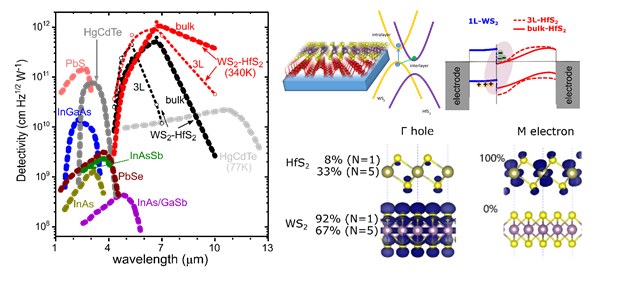IMRE NEWS
High Oscillator Strength Interlayer Excitons in 2D Heterostructures for Mid-IR Photodetection

The low exciton binding energy and requirement for lattice matching in traditional compound semiconductors used in infrared (IR) optoelectronics have restricted their possible operation temperature and reachable working wavelength. IMRE scientists together with collaborators demonstrated IR photodetection enabled by interlayer excitons (ILEs) generated between tungsten and hafnium disulfide, WS2/HfS2. The photodetector operates at room temperature and shows even higher performance at higher temperatures owing to large exciton binding energy and phonon assisted optical transition. The unique band alignment in WS2/HfS2 heterostructure allows interlayer bandgap tuning from mid- to long-wave infrared. The sizeable charge delocalisation and ILE accumulation at the interface are postulated to be responsible for the greatly enhanced oscillator strength of ILEs and high responsivity of the photodetector. The work provides a glimpse of the physics of ILEs in the unique heterostructures and offers a promising technology for IR photodetector and potentially photoemitter.
Reference:
Steven Lukman et al., "High oscillator strength interlayer excitons in two-dimensional heterostructures for mid-infrared photodetection", Nature Nanotechnology 15, 675-682 (2020)
Link to online version of paper in Nature Nanotechnology.
A*STAR celebrates International Women's Day

From groundbreaking discoveries to cutting-edge research, our researchers are empowering the next generation of female science, technology, engineering and mathematics (STEM) leaders.
Get inspired by our #WomeninSTEM
.png?sfvrsn=b59474e9_3)